| View previous topic :: View next topic |
| Author |
Message |
Gulfcoastjohn
Joined: 03 Oct 2017
Posts: 78
City/Region: Pensacola
State or Province: FL
C-Dory Year: 2010
C-Dory Model: 255 Tomcat
Vessel Name: CAT 'O MINE
Photos: CAT 'O MINE
|
 Posted: Fri Oct 06, 2023 10:01 pm Post subject: Locking; Meet in the Middle briefing 2023 Posted: Fri Oct 06, 2023 10:01 pm Post subject: Locking; Meet in the Middle briefing 2023 |
 |
|
LOCKING, Meet in the Middle brief
The most important aspect of locking without drama is to practice your skills on your boat in close quarters maneuvering, including against adverse winds and currents, EXACTLY like when you are DOCKING (Credit to Colby Smith/C-Traveller crew). This was our toughest parallel parking task in a very busy canal, and full of laughs:
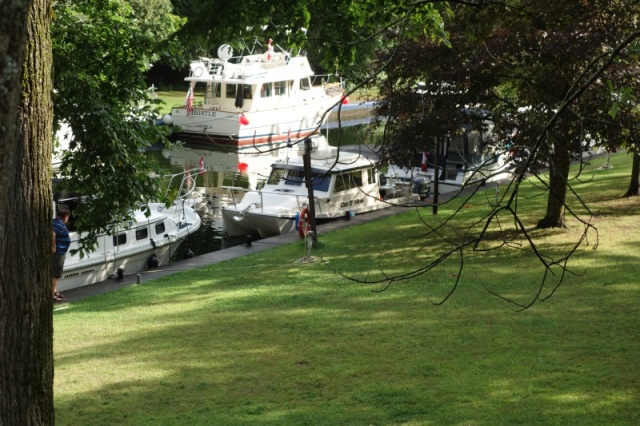
If you can squeeze your boat in between two others on a dock and secure your lines despite adverse winds and currents, then you can do it in a lock. That’s the toughest part…the rest involves knowing what to expect, preparation prior to the Arrival Point, enjoying the ride up or down, and knowing how and when to exit safely.
PREPARING FOR ARRIVAL
Detailed info about every lock (or series of locks) is available online and in your favorite cruising guide (we like the spiral Waterway Guide books while underway, possibly without cell coverage, but we confirm it using WWG Explorer Online when wi fi or cell service is available). Every named waterway route is charted in Statute Miles by the USACE. Those Army troops are not nautical folks so they don’t do knots (nautical miles per hour) or nautical miles. So choose the Statute Miles option on your plotter. Every fork, marina, bridge and lock location on every named waterway is given as a Statute Mile location. However, your preferred navigation app or plotter might not list ANY SM numbers on the chart, (ie our Garmin 8212/8012).
Navionics, OPN Capn, and Coastal Explorer show some SM marks, but that short purple line with a number on it may be five or ten miles away or more. AquaMaps Marine ($50 smartphone or tablet only no laptop) to the rescue…just touch any spot on the waterway line to open a dialogue box which shows your current or any future SM location to 1/10th of a mile. This is much simpler than setting your odometer to zero and adding, say, 176.3 miles to get your current SM position on a river or ICW or even Canada Georgian Bay/Northern Small Boat Passage charts.
Another huge Aquamaps Marine advantage is that it is the ONLY nav app which takes a stab at charting No Wake Zones, which make up much of Florida. Aquamaps can’t show AIS or radar targets or depth or engine data like your MFD can…but we like it!
One attendee cited the Knowake app, but I was unable to find a legend or the ‘no wake zones’, likely my bad.
If you like an auto-route feature on your app or MFD, you can mark the Lock entrance as a waypoint and watch the miles count down.
River bridges, marinas, locks etc will also be listed as RDB or LDB (Right or Left Descending Bank as the river flows). On the Gulf and Atlantic ICW, your references will refer to the East or West side instead of RDW on the rivers that make up the GICW and AICW. Of course, those rivers are affected by tides, not altitude. Some locks have a large lock chamber for tows with barges and a smaller auxiliary chamber for pleasure boats, so you need to know which is where long before you approach it.
In some locks ALL vessels must tie off to the port wall, in others only to the starboard wall. Check this long before you arrive. If your cruising guide identifies a ‘preferred’ side or position it’s because it’s away from the giant fill valves and calmer. ALWAYS have big fenders on BOTH sides of your boat so if you are allowed to choose sides you can change plans without frantically moving fenders. The Lockmaster may direct another vessel to raft to yours, or you may request to raft to another vessel. You don’t want to raft to a tow boat unless he agrees to let you out before throwing his three 3,000HP engines in gear.
It may be your boat, but when it’s in or around a lock the Lockmaster is in charge.
AIS is invaluable on the rivers. You can look ahead to see if and how many commercial tows may be ahead of you. They have priority. A barge with HAZMAT materials (“Red Flag loads”) must be locked through alone. Large tows (up to 40 giant barges) may have to be broken up and locked through in groups…a chore that can take three to ten hours or more.
The big locks mostly use a floating ‘bit’ or post that rides up a track within a niche in the lock chamber wall. They may be 60 feet apart (or 120 feet if one is missing). Loop your bow and stern lines around the floating bit, but don’t cleat them off. You want the floating bit to be as close to midships as possible while still staying inside your boat, ie the forward section of your cockpit. The official USACE recc’d for recreational boaters it to use two minimum 50 foot lines, but that’s overkill for a C-Dory.
The small historic NY and Canada locks mainly use weighted ropes (not attached to the bottom) or plastic coated cables that are anchored to the bottom of the lock chamber that are 12 feet apart.
Those small locks might have the water rise in the chamber to within a few inches of the tops of the chamber walls…so you need to let out your lines and adjust your fenders (not ‘bumpers’) to float sideways at your boat’s water line for some hull protection if there is some wind.
Also be aware that in those locks the wooden blocks that protect the plastic coated cables from being chafed against the top of the cement chamber walls can also capture your loop line. So much to be aware of. There will be a crowd of tourists snapping photos of your mistakes, or even if you don’t make any.
APPROACHING A LOCK
So now you should know your boat icon SM location and the exact SM location of the correct lock gate. The next step is learning how to let the Lockmaster know that you want to lock through.
Conventional Wisdom is to keep your Radar running underway in order to comply with the conventional wisdom that you should always maintain every method available to avoid collision. However, if you have the old magnetron technology like our Garmin XD24, turn it off when the dome will be level with other folks eyeballs in close quarters like a Lock…the microwaves can damage eyeballs. Turn it back on outside the Lock and away from eyeballs.
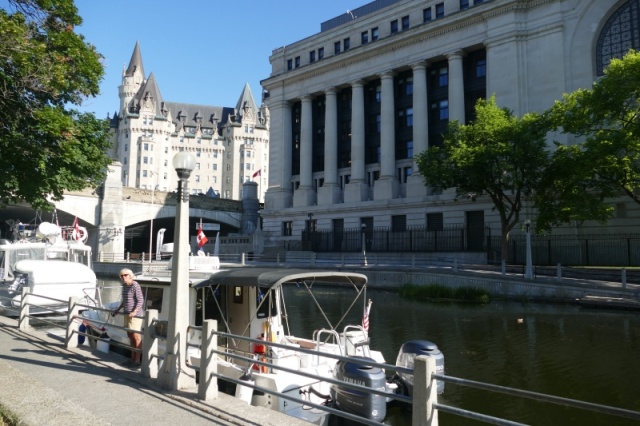
(On the Blue Line above the Ottawa Flight of Eight Locks).
Most locks do not have AIS. Most locks have a charted “Arrival Point” with signs. Directions on those signs may include one or any combination of the these possibilities:
No Smoking
Turn off engines afer securing to your vessel (it was very surprising to me how many attendees including some Gold Loopers noted that there was was no prohibition to keeping engines on).
Some locks use PA systems for vessel instructions
Contact the Lockmaster on a designated VHF Channel. Be sure to switch your ship VHF to Lo Power, or (preferred) only use a HH VHF, which is limited by the FCC to a max of six watts, about three miles, not 25 watts. They don’t need to hear you in Nashville.
To establish initial VHF contact, you do not have to repeat three times ie “Joe Wheeler Lockmaster (just once), this is Cat O’ Mine, downbound.” Keep the HH VHF, boat hook, and locking gloves in the cockpit or else you’ll forget to bring them back there after each lock in the series.
Or… Stop and hold at the Arrival Point if a signal light is red (you may need binocs to find or see the signal light).
Depending on the Lock, the signal light might be steady or flashing Green, Green and Yellow, or Red (yet another reason to read up on what you should expect).
Do NOT EVER go past the Arrival Point if the chamber is not ready. When big chambers are emptying they can make a terrifying current if you are too close.
After gates are open and the signal light turns green you may enter the lock chamber without any verbal contact with the Lockmaster.
or….Call the designated phone number.
or…In the Canada Historic canals, Tie off on the Blue Line and don’t contact the Lockmaster (Canada Trent Severn except VHF 14 for Lock 1 (see footnote), plus Rideau, Richelieu, LaChine and Chambly historic canals).
Tying up on The Blue Line is your visual signal to the Lockmaster that you want to lock through. (None of this applies in the USA). Don’t even tie up on the Blue Line for 5 minutes for lunch! You can stay overnight on the blue line after the lock closes IF you vacate before the first locking of the next day, or on the gray line anytime, though currents from lock chambers emptying can be bothersome.
Or…some locks may have a pull rope for very small craft ie kayaks, SUP.
and…If it’s your first lock, tell the lockmaster nicely and request his/it’s expertise on where to tie off to get the smoothest ride in your little boat. 99.9% of Lockmasters are very nice and helpful.
The ride UP is ALWAYS much rougher than the ride DOWN.
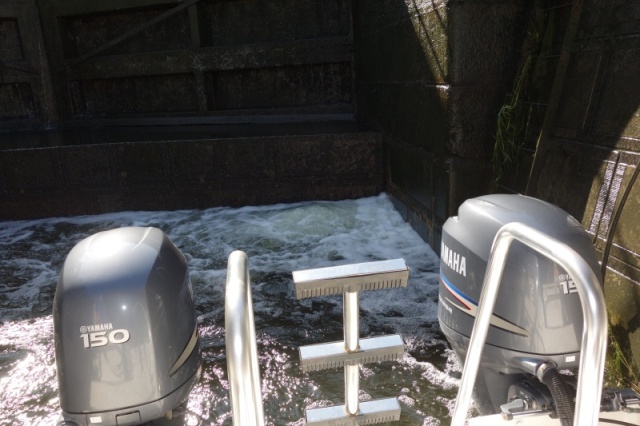
This Erie Canal lock with no boats in it is getting an expedited fill.
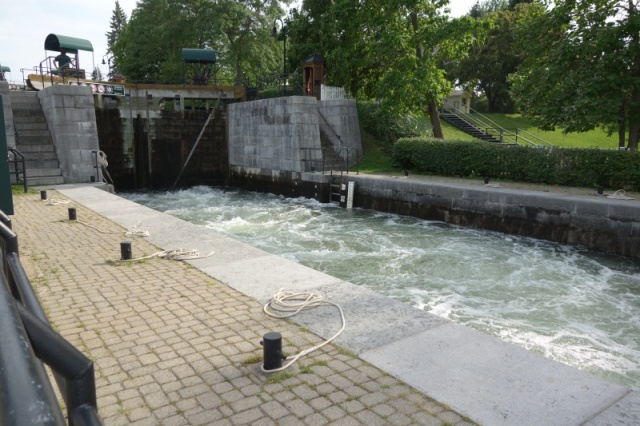
The proper nautical way to secure your fenders to your rails (you want to save your cleats for your dock lines) is a clove hitch, which Eileen has never been able to master in the dark and in rain or under stress. She prefers FenderGrips, the genuine Delrin and SS springs, some of ours are 30 years old. If you choose to do so, get the genuine brand with SS springs for about $15 each online. (Bob and Marie are chortling).
ENTERING THE LOCK CHAMBER
You should already know how far apart floating posts vs cables vs ropes are. In US locks you want to loop a bow and stern line around the floating post and hold them (don’t cleat them off).
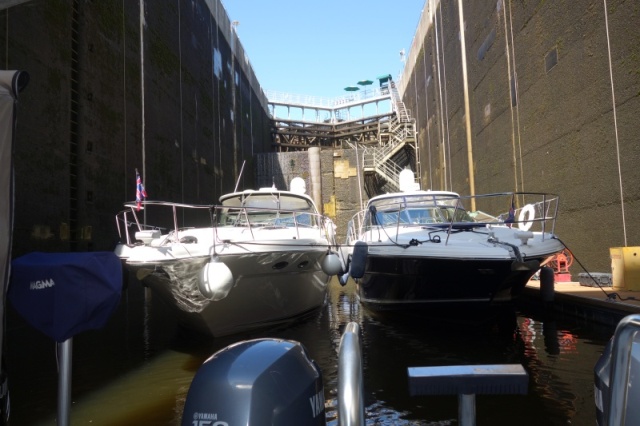
Enter at dead idle to avoid wakes that ricochet off the lock walls and upset other boats. Visually scout out where you want to tie off based on the Lockmaster rec’d for your boat. Since your helm is to starboard, it will be easier to look down on your starboard rub rail through your std window directly to see how close you are to the chamber wall.
The upper lock chamber will always have a flag (or windsock) flying….look carefully to see how much wind and from what direction you will have to deal with. It can be very surprising how much different winds can be at the bottom vs the top of any lock chamber. In VHF locks, ask the Lockmaster about wind and current upside.
Generally, the first boat in is the first boat out, and you will be expected to tie off as far into the lock as possible. Be sure that you recognize where the gates fold in (marked) so your bow doesn’t get crushed by them. When locking UP look UP to ensure that your fenders won’t get trapped in some bollard niche or ladder. Millions of gallons of water will be pushing/pinning your boat against the chamber wall, and you or ten men won’t be able to push your C-Dory off the wall against that power. Fender entrapment can capsize boats.
Don’t use big/thick fender lines. ⅜ is good for C-Dorys. You may need to cut a fender line that gets hung up in a niche or that’s attached to a floating ‘bit’ that gets hung up in its’ track. Never cleat your line(s) on the boat, but it’s OK to take one loop around a cleat and hold on to that end. Have a Canada-legal blunt tip line cutter (not a ‘weapon’) ready to cut your lines if they start to get hung up.
The WORST thing that can happen during a lock ride is that a fender or bollard gets hung up and results in your C-Dory getting suspended along the chamber wall by its’ lines. Then cleats rip out and your boat falls sideways into the water, dumping all crew in a multiple MOB with your boat falling on top of them all in a draining lock that is trying to suck them all out and then spit them out on the other side of the dam. Dam bad day. It may take over a minute for the lockmaster to either open or close the lock chamber valves, which can be many feet in diameter.
If you use relatively small fender lines (⅜ for a CD25) and you have to cut your fender lines before your boat gets hung sideways on a chamber wall the WORST thing that can happen is that your boat gets pushed over to the other wall or into other boats there (that’s yet another reason to have full protective fenders on BOTH sides of your boat).
As soon as your boat is secure inside the lock chamber, cut off engines. In VHF locks, radio (on LO power) “Cat O’ Mine Secure”. (Any tows in the lock do not cut off engines).
EXITING THE LOCK
Don’t restart engines until the gates are open and the horn, buzzer (or other) signals to exit. Vessels Exit in the same order they entered, so remember that order.
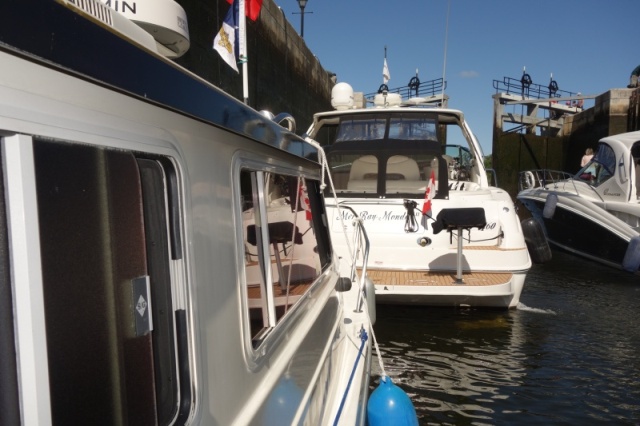
Be prepared for delays. When a valve won’t fully open on a giant Tenn river lock, the Lockmaster can’t fix or even diagnose it…he has to wait for the designated USACE lock engineer to drive over and diagnose the issue. It could take hours or it could take days or (rarely) even weeks to fix. Fortunately, we C-Dorys can portage around such problems from the nearest boat ramp.
The longest we have been delayed to date was 12 days on the Western Erie Canal system when the ENTIRE system was fully closed due to flooding from record rains. Lockmasters told us their record was 21 days fully closed in 2017.
SAFETY
Add some Seadog 12” grab handles (which match the C-Dory OEM) in every area so that you can grab two at all times. Eileen and I tend to generalize, rightly or wrongly, that many C-Dory owners are, or could be, grandparents on Social Security who are one step away from a life changing fall that could change our lives for the worse. Although we have previously chosen to use manual (only) inflatable PFD’s when locking in the rain, if you take a tumble hitting your head and are unconscious, you can’t pull the manual cord and it won’t inflate.
We now advocate wearing a comfortable inflatable AUTO INFLATING PFD when locking or outside the cockpit which meets current USCG requirements for not having to wear it in order for it to count for ‘carriage’ on the boat. The ONLY way to tell for sure is to read the label on the PFD. Many that have a clear plastic cover over the firing mechanism that shows the green indicator that it is ready to fire now meet that requirement for about $149 on sale. Although rain can dissolve the aspirin like ‘bobbin’ and set it off, we think the newer inflatable PFDs are worth the money. Consider it.
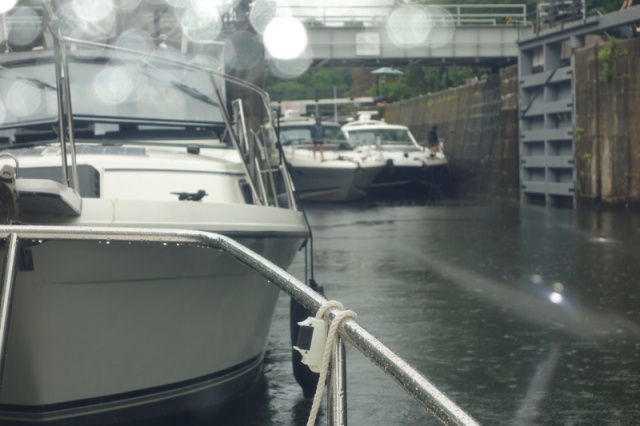
The aspirin like ‘bobbin’ must be replaced at three years from the stamped mfg date (which may be a year before your purchase date), all run around $25. Failure/old age of the bobbin results in inflation, not failure to inflate. Replace the the CO2 cartridge that inflates it at the same time. More expensive inflatable PFD’s use ‘hydrostatic’ mechanisms that only inflate if they are under at least four inches of water (not in the rain) but they must be replaced at five years and run $75.
We now advocate that C-Dory captains in the small historic Locks on the NY and Canada systems grab and wrap a cable from out the helm window, then back up (while letting out a loop of line around the cable) to allow the crew to snag a rear cable. This avoids either of us being outside the boat, where the risk of a MOB is much higher. Eileen really enjoyed catching a cable out on the bow, but with age comes some wisdom, or a little bit, only sometimes, with some folks.
We added a cockpit ‘locking cleat’ to loop a line around (but NOT cleat off) when locking. Remove the gunnel insert for access and secure with fender washers. We secure the bow line back to this cleat while underway so we don’t have to leave the cockpit to go fetch the bow line.
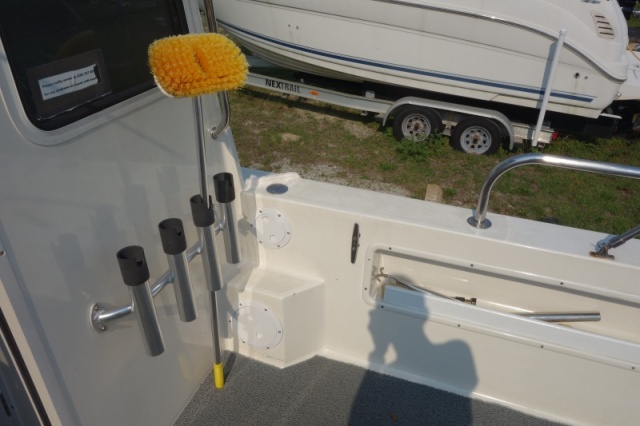
SUMMARY:
Consult your fav Cruising Guide for Locking details and know them 20 SM away
No smoking.
Be prepared to turn engines off or keep them on depending on the rules of the Lock. (There was a surprising amount of variability on this within our very experienced group).
Position your Locking HH VHF, locking lines, boat poles (at least two), bumpy gloves and lines in the cockpit 10 SM away. Dr. Bob noted that the cheap twist grip extension boat hooks (ie West Marine) collapse under pressure much more than the sturdier Shurehold SS versions.
https://shurhold.com/collections/ready-to-go-kits/products/new-boater-kit
Get a grip on your status using AIS 5-10 miles away and contact the Lockmaster when in sight of the Lock or even much sooner to decide whether to overnight before that lock.
Know your Arrival Point instructions at least 5 miles out from them
Be professional and polite when dealing with Lockmasters and Tows…know the “see you on the One” and “See you one the Two” whistle lingo. Regardless of whether you are ‘overtaking’ or ‘meeting’, One Whistle means you should steer your C-Dory to the RIGHT of the tow.
Ask the Lockmaster if he/she etc has any recc’d for your little boat
Be prepared for very different wind and wave conditions at the top of a Lock vs the bottom (watch the flag and ask the Lockmaster)
‘Downbound’ refers to the river direction, not the South direction. A few rivers run North, including the St John. and Welland canal locks.
No USA locks require a crew of two, but the Quebec and some other Canadian locks (Chambly, St Ours, Carrilion,) require a minimum crew of two, and the Welland canal requires a professional captain upbound meaning southbound).
The most unique C-Dory exception to the usual Looper guidance is that if you do the Triangle Loop into Canada (and you SHOULD!) you can take the historic LaChine canal right through Montreal (five easy low locks where you tie up to floating docks) rather than the horrid St Lawrence Seaway commercial Locks. You must get your air draft to under 8 feet, which means for us taking off the radar dome,which is only four bolts and two quick disconnects. The AGLCA added this 8 ft clearance to their Official Air Draft Guidance after we suggested it.
The better prepared you and your crew are, the more likely that your ‘Locking Through’ experience will be stress free, routine, safe and enjoyable.
Helpful References:
https://www.usace.army.mil/Missions/Civil-Works/Navigation-Locks/
https://usace.contentdm.oclc.org/digital/collection/p16021coll11/id/2887
There’s lots of U Tube videos…
We hope that something here is helpful to you!
Safe Travels!
PM me if there is anything we can help you with.
John and Eileen
_________________
John and Eileen Highsmith
2010 TC255 Cat O' Mine
Yamaha F150's |
|
| Back to top |
|
 |
txmntman
Joined: 10 Mar 2009
Posts: 81
City/Region: GEORGETOWN
State or Province: TX
C-Dory Year: 2006
C-Dory Model: 22 Cruiser
Vessel Name: Saint Somewhere
Photos: Saint Somewhere
|
 Posted: Fri Oct 06, 2023 10:10 pm Post subject: Posted: Fri Oct 06, 2023 10:10 pm Post subject: |
 |
|
Good stuff, John! You gave a really full, content rich presentation. Thank you for making the “Meet in the Middle” gathering a success!!!
_________________
CD 22 “Saint Somewhere” 2020 - Present
SeaSwirl 1850 Striper "Nicky" Sold
Alumicraft Sold
Boston Whaler Montauk "Joe Bob" Sold
Hobie Cat "Mikey Likes It" Sold |
|
| Back to top |
|
 |
Peter & Judy
Joined: 03 Dec 2014
Posts: 550
City/Region: Olds
State or Province: AB
C-Dory Year: 2005
C-Dory Model: 22 Cruiser
Vessel Name: Mistaya
Photos: Mistaya
|
 Posted: Sat Oct 07, 2023 11:01 am Post subject: Posted: Sat Oct 07, 2023 11:01 am Post subject: |
 |
|
| Quote: | | This was our toughest parallel parking task in a very busy canal, and full of laughs: |
If you want to learn how to parallel park, go to Italy. I just spent a month in Italy and it is amazing to see how Italians can squeeze a car into the smallest spaces. I'm sure they could do the same with a boat. Maybe a boating trip to Italy would also be a great learning experience.
_________________
Peter & Judy Haase
Buffalo Horn Ranch
HMCB Mistaya
"Mistaya" (Grizzly Bear in Cree)
HMCB (Her Majesties Cute Boat) |
|
| Back to top |
|
 |
Robert H. Wilkinson
Joined: 26 Jan 2011
Posts: 1234
City/Region: Port Ryerse
State or Province: ON
Vessel Name: Romakeme IV
Photos: Romakeme IV
|
 Posted: Mon Oct 09, 2023 1:51 pm Post subject: Posted: Mon Oct 09, 2023 1:51 pm Post subject: |
 |
|
Thanks John for putting together this excellent instructive guide to locking. It should be archived here somewhere for members to find easily in the future. Don't think there is a forum specifically for locking.
I live near the Trent Severn and have spent about 6 weeks on it but I always go after Labour day when the rush is over. If you go during July/August you and your boat need to be well prepared and if its your first lock experience then reading up on things like this thread is a GOOD idea  
Regards,
Rob
_________________
Talk to me and I will listen-- but if its not about boats or fishing all I will hear is bla,bla,bla,yada,yada,zzzzzzzz |
|
| Back to top |
|
 |
colbysmith
Joined: 02 Oct 2011
Posts: 4549
City/Region: Madison
State or Province: WI
C-Dory Year: 2009
C-Dory Model: 25 Cruiser
Vessel Name: C-Traveler
Photos: C-Traveler and Midnight-Flyer
|
 Posted: Tue Oct 17, 2023 10:37 pm Post subject: Posted: Tue Oct 17, 2023 10:37 pm Post subject: |
 |
|
Many of the locks I have gone through use a floating bollard. Here is a close up photo of my lines around one in the Cordell Hull Lock. One line is from my stern cleat, the other from the forward cleat. Colby
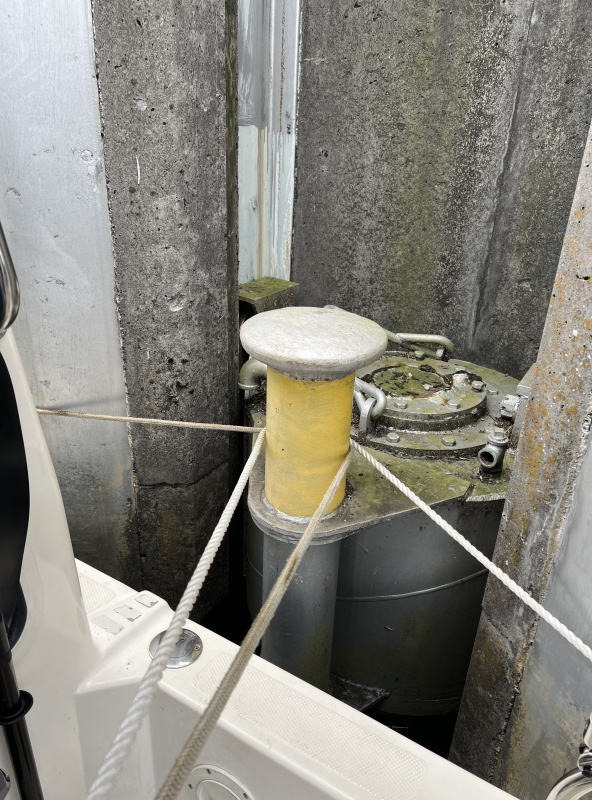 |
|
| Back to top |
|
 |
colbysmith
Joined: 02 Oct 2011
Posts: 4549
City/Region: Madison
State or Province: WI
C-Dory Year: 2009
C-Dory Model: 25 Cruiser
Vessel Name: C-Traveler
Photos: C-Traveler and Midnight-Flyer
|
 Posted: Wed Oct 18, 2023 10:30 am Post subject: Posted: Wed Oct 18, 2023 10:30 am Post subject: |
 |
|
Something else, I don't think was mentioned. Many times a lot of debris gets trapped in the locks, and it tends to float near the lock gates. I entered one lock on the Columbia one time that we had to literally push through the logs as they completely blocked the entry. If you look closely behind me here in the Cordell Hull lock, you can see quite a bit of drift wood. Just something to be mindful of when entering a lock. Colby
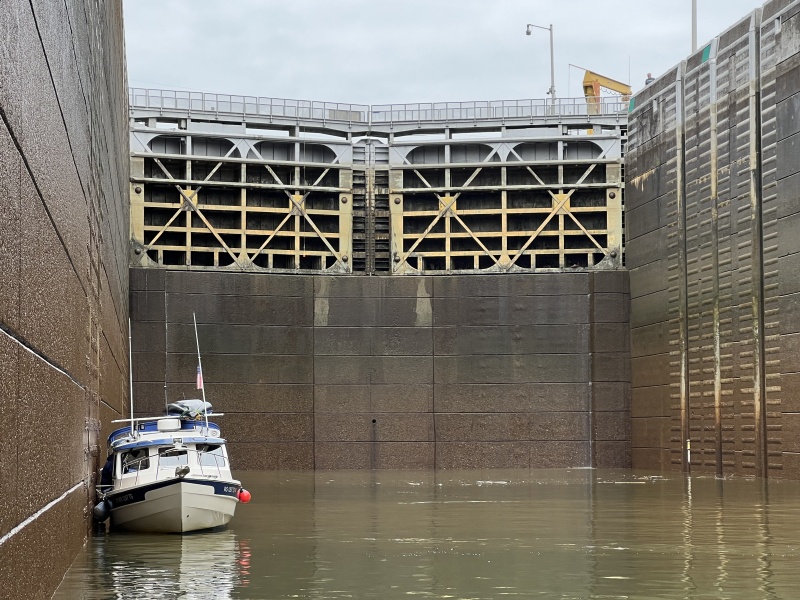 |
|
| Back to top |
|
 |
Gulfcoastjohn
Joined: 03 Oct 2017
Posts: 78
City/Region: Pensacola
State or Province: FL
C-Dory Year: 2010
C-Dory Model: 255 Tomcat
Vessel Name: CAT 'O MINE
Photos: CAT 'O MINE
|
 Posted: Wed Oct 18, 2023 5:40 pm Post subject: Posted: Wed Oct 18, 2023 5:40 pm Post subject: |
 |
|
Colby,
Thanks for the floating bollard pic with fore and aft lines around it (with fore and aft fenders against the wall). This is the method directed by the USACE locks for recreational small boats in the link (‘small’ is not defined).
https://usace.contentdm.oclc.org/digital/collection/p16021coll11/id/2887
Many Loopers devise a single line ‘bollard loop’ with a stiff hose around a five foot eye loop. This makes it easier to toss from a distance. Their boat's gunnel may be too high to easily reach around the pin. That method may not be secure enough when riding up if the line is higher than the pin. I can’t find pictures of one except on the greatloop.org site, which can’t be accessed by non-members.
Anyway, it makes sense to me to follow USACE directions when in a USACE lock whenever possible.
Excellent point about the logjams that can collect in and around the locks!
John |
|
| Back to top |
|
 |
|
|
You cannot post new topics in this forum
You cannot reply to topics in this forum
You cannot edit your posts in this forum
You cannot delete your posts in this forum
You cannot vote in polls in this forum
You cannot attach files in this forum
You cannot download files in this forum
|
|

 Search
Search Private Messages
Private Messages Profile
Profile Log in
Log in Register
Register Help
Help












